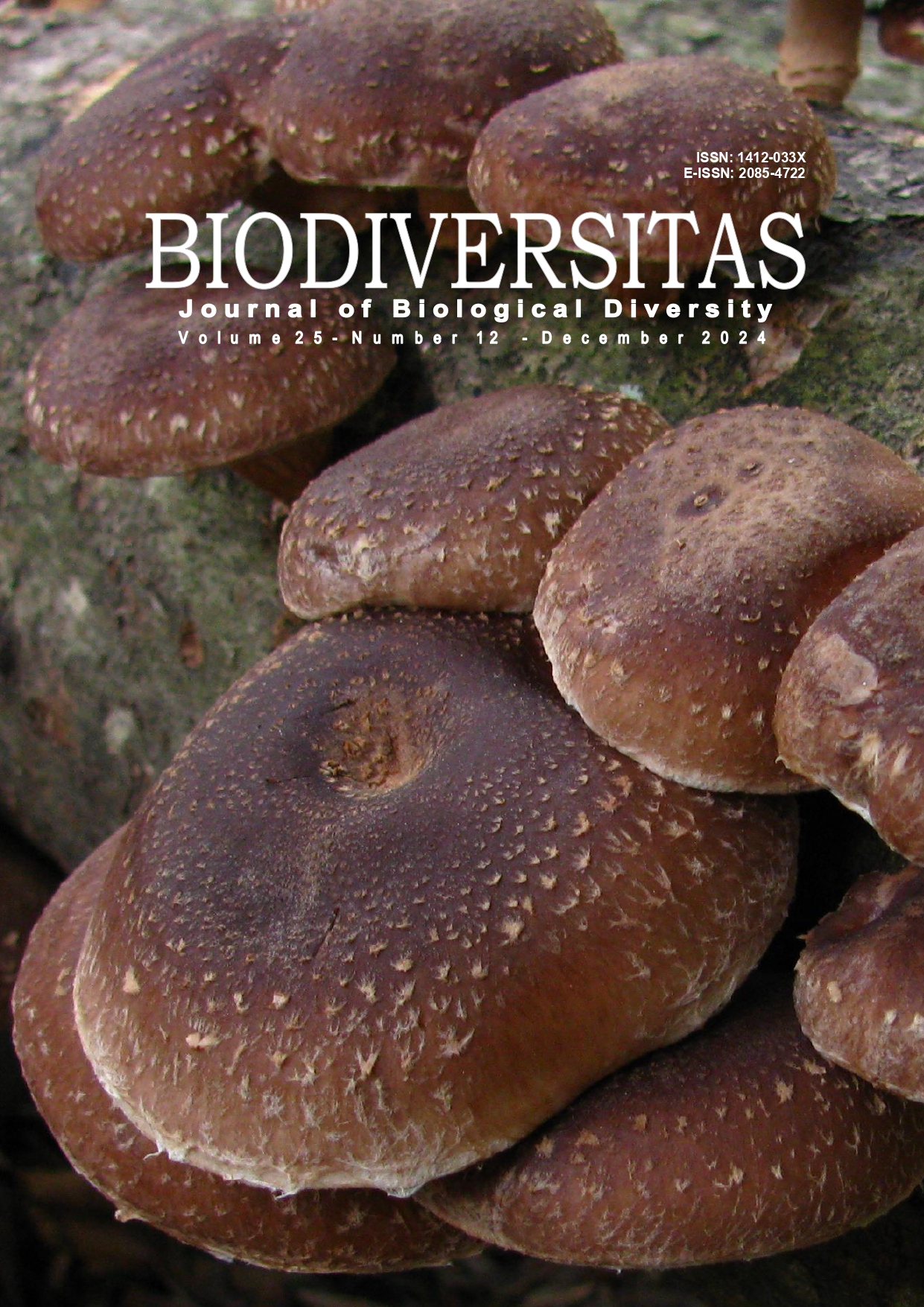Molecular identification of rhizospheric Actinomycetes from karst ecosystems of Gorontalo, Indonesia, and its seed germination induction capability of Zea mays var. doti
##plugins.themes.bootstrap3.article.main##
Abstract
Abstract. Retnowati Y, Katili AS, Kandowangko NY, Pembengo W. 2024. Molecular identification of rhizospheric Actinomycetes from karst ecosystems of Gorontalo, Indonesia, and its seed germination induction capability of Zea mays var. doti. Biodiversitas 25: 4763-4771. Karst, as an extreme ecosystem, was a source of diverse Actinomycetes with varied biological activities. This study explored the plant-growth-promoting potential of rhizospheric Actinomycetes from the karst ecosystem of Gorontalo, with a focus on inducing seed germination in Zea mays var. doti. Four locations in Gorontalo were selected to explore Actinomycetes, targeting approximately 20 different rhizospheric plant species to isolate these microorganisms. Among the 25 isolates obtained, representing diverse morphological types from 12 rhizospheric plants, eight actinomycete isolates exhibited phosphate-solubilizing activity and produced indole-3-acetic acid (IAA). The 16S rRNA gene sequence analysis showed that approximately 75% of the isolates belonged to the Streptomyces genus, including Streptomyces cavourensis strain KRZm-02, Streptomyces sp. strain KRZm-03, Streptomyces pratensis strain KRLl-01, Streptomyces carpaticus strain KRIt-01, Streptomyces sp. strain KRIt-02, and Streptomyces aquilus strain KRPa-01. Additionally, 12.5% of the isolates were identified as Nocardiopsis alba strain KRZm-01 and Micromonospora sp. strain KRPt-01, respectively. The two isolates with the highest plant-growth-promoting potential, Streptomyces pratensis strain KRLl-01 and Streptomyces carpaticus strain KRIt-01, were further tested for their ability to promote germination of Zea mays var. doti seeds over 7 days. Among the two, Streptomyces carpaticus strain KRIt-01 exhibited the highest germination-inducing potential. Overall, the karst ecosystem of Gorontalo offers a valuable reservoir of biological resources with the potential for Plant-Growth-Promoting Rhizobacteria (PGPR). Further studies on the application of these actinomycete isolates as biofertilizers in agricultural and plantation crops could significantly contribute to improving crop growth and productivity, thereby revolutionizing agricultural practices.
##plugins.themes.bootstrap3.article.details##
Most read articles by the same author(s)
- YULIANA RETNOWATI, LANGKAH SEMBIRING, SUKARTI MOELJOPAWIRO, TJUT SUGANDAWATY DJOHAN, ENDANG SUTARININGSIH SOETARTO, Diversity of antibiotic-producing Actinomycetes in mangrove forest of Torosiaje, Gorontalo, Indonesia , Biodiversitas Journal of Biological Diversity: Vol. 18 No. 4 (2017)
- ABUBAKAR SIDIK KATILI, YULIANA RETNOWATI, Short Communication: Isolation of Actinomycetes from mangrove ecosystem in Torosiaje, Gorontalo, Indonesia , Biodiversitas Journal of Biological Diversity: Vol. 18 No. 2 (2017)
- NOVRI YOULA KANDOWANGKO, MUKHLISULFATIH LATIEF, RAMPI YUSUF, Short Communication: Inventory of traditional medicinal plants and their uses from Atinggola, North Gorontalo District, Gorontalo Province, Indonesia , Biodiversitas Journal of Biological Diversity: Vol. 19 No. 6 (2018)
- RAMLI UTINA, ABUBAKAR SIDIK KATILI, NURAIN LAPOLO, TALHA DANGKUA, Short Communication: The composition of mangrove species in coastal area of Banggai District, Central Sulawesi, Indonesia , Biodiversitas Journal of Biological Diversity: Vol. 20 No. 3 (2019)
- JUSNA AHMAD, NOVRI YOULA KANDOWANGKO, MARGARETHA SOLANG, ERWIN NADJAMUDIN, Morphological characteristics and nutritional value of binthe kiki, a local maize variety from Gorontalo, Indonesia , Biodiversitas Journal of Biological Diversity: Vol. 22 No. 8 (2021)
- ABUBAKAR SIDIK KATILI, RAMLI UTINA, YOWAN TAMU, ELYA NUSANTARI, Management of coastal biodiversity based on social-cultural values in constructing conservation character education , Biodiversitas Journal of Biological Diversity: Vol. 19 No. 5 (2018)
- YULIANA RETNOWATI, ABUBAKAR SIDIK KATILI, Identification of fermentative bacteria on local microorganisms of golden snail (Pomacea canaliculata Lamarck, 1822) , Biodiversitas Journal of Biological Diversity: Vol. 22 No. 2 (2021)
- YULIANA RETNOWATI, NOVRI YOULA KANDOWANGKO, ABUBAKAR SIDIK KATILI, WAWAN PEMBENGO, Diversity of actinomycetes on plant rhizosphere of karst ecosystem of Gorontalo, Indonesia , Biodiversitas Journal of Biological Diversity: Vol. 25 No. 3 (2024)

